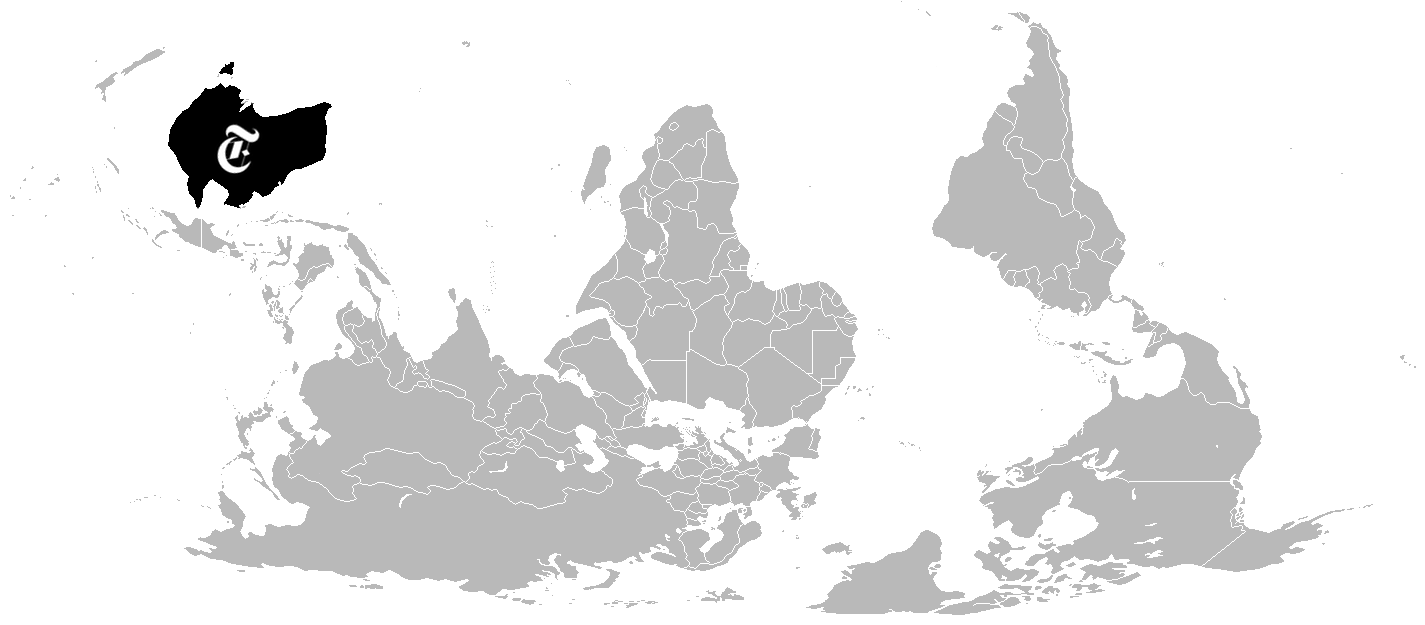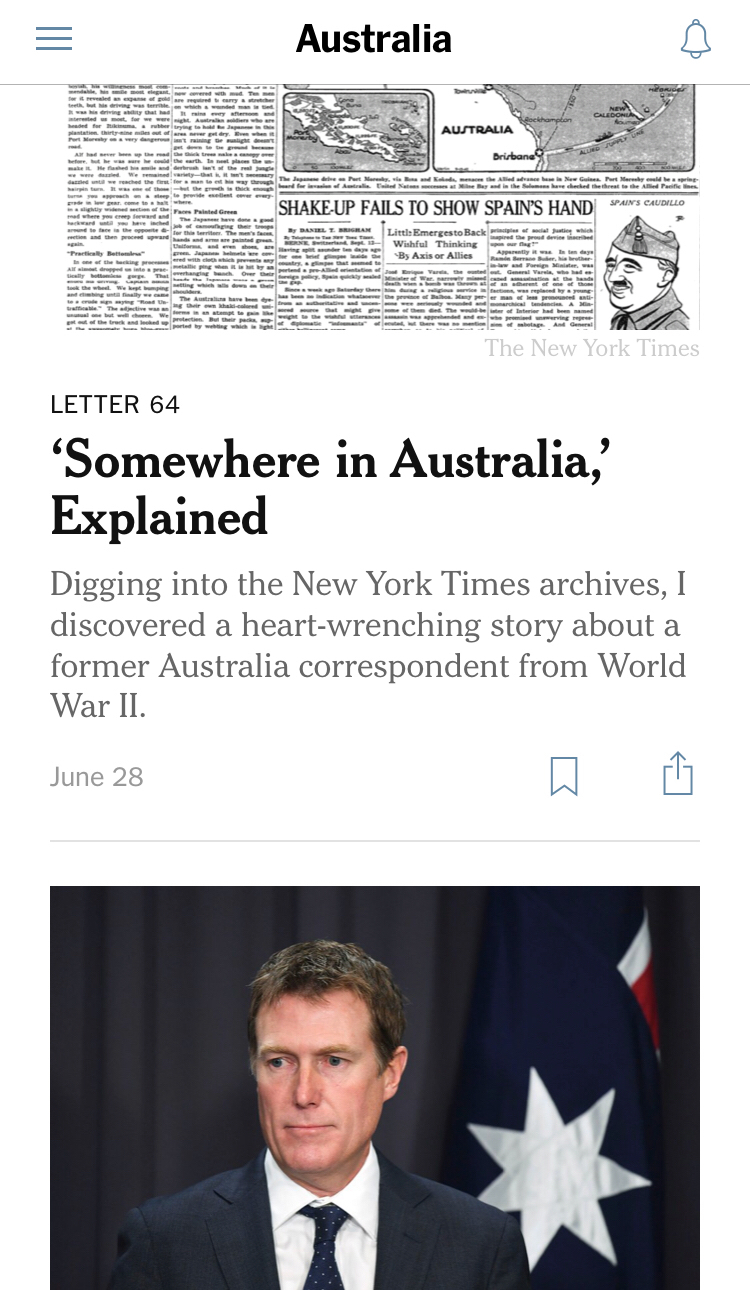
These are numbers that shout opportunity, seized.
The New York Times now has around 2.33 million paid digital-only news subscribers (not counting subscribers to Crosswords and Cooking). 15 percent of those subscribers are from outside the United States. The New York-based, East-Coast-centric news organization is now seeing higher growth rates outside the U.S. than within it.
Canada was the biggest market for the Times outside the U.S., even before the Times began officially devoting more resources to growing its reporting and subscriber base in the country. Now Canadian subscribers make up around 27 percent of the Times international subscriber base, according to a Canadaland interview with Times Canada bureau chief Catherine Porter this past spring; that works out to something like 94,000 subscribers. (2,330,000 × .15 × .27 = 94,365.) By some estimates, that’s more paying Canadian digital subscribers than any Canadian news organization can claim.
The Times officially began building out its presence in Australia at the beginning of last year, as part of a three-year, $50 million-plus global expansion plan — and now Australia is its fastest growing market for subscribers. (Again, by percentage growth — the Times didn’t share country-by-country subscription numbers.)
So how has the Times approached building up coverage, using a relatively lean editorial staff, that can convince English speakers in other countries to pay for the Times, despite many local alternatives have been covering their respective countries for longer?
“One of the things we always talk about is our cocktail of content — that is, what mix of New York Times stuff is going to make somebody, particularly somebody far away, or somebody who doesn’t feel today the Times is for them right now, think that this is totally relevant for me, and I want to have a relationship with that news organization?” Jodi Rudoren — newly promoted to associate managing editor for audience this month — told me. (Rudoren will still be overseeing the Times’ international expansion efforts as part of the new role; the work is just reframed slightly to fall under the wider mandate of expanding coverage and identifying underserved audiences.)
The individual components aren’t surprising.
 “Local stuff will overindex everywhere,” Rudoren said, so a Times push into a new geographical region necessarily means more geographically specific coverage. Then, “we make sure we make stuff that’s big everywhere. Every piece of content we produce for Australians may be overindexing in Australia, but that’s still probably a smaller number of Australians than all the Australians who are reading, say, our Harvey Weinstein investigation.”
“Local stuff will overindex everywhere,” Rudoren said, so a Times push into a new geographical region necessarily means more geographically specific coverage. Then, “we make sure we make stuff that’s big everywhere. Every piece of content we produce for Australians may be overindexing in Australia, but that’s still probably a smaller number of Australians than all the Australians who are reading, say, our Harvey Weinstein investigation.”
She pointed to the organization’s approach with Peter Goodman’s piece on the repercussions of a near-decade of budget-cutting in Britain; about 20 percent of the story’s readers came from the U.K.
“Then, when we’re able to connect the global and local, it’s very powerful for people,” Rudoren said. A Q&A with Maggie Haberman (American) and Times Sydney bureau chief Damien Cave (also American) in the aftermath of Donald Trump’s meeting with Australian prime minister Malcolm Turnbull is one example of that Timesian cocktail.
“Then the last ingredient, is how we stir that cocktail. We don’t want to do commodity news in local markets. We need to have the Times special sauce, whether that’s more analysis, more visuals. We are not trying to match The Australian page-for-page, or any other local paper that might be in that market.”
This approach muddles a simplistic demographic portrait of an international Times subscriber. In Australia, for instance, “we’re still aiming for an audience of Australians, and a global audience at the same time, to some degree,” Cave, told me. “Our audience both in Australia and outside Australia is diverse, and includes a whole lot of people in the country who may have moved here from other countries, and includes Australians who live in other parts of the world. I get emails from Australians in Malaysia. I get emails from Americans in Sydney.”
 Rudoren was hesitant to pin down a playbook for how the Times launches in other countries, though the editorial push in Australia was something of an incubator for audience development ideas and testing that “cocktail of coverage.” Both she and Cave used “experiment,” “learning,” and “audience-focused” liberally.
Rudoren was hesitant to pin down a playbook for how the Times launches in other countries, though the editorial push in Australia was something of an incubator for audience development ideas and testing that “cocktail of coverage.” Both she and Cave used “experiment,” “learning,” and “audience-focused” liberally.
“We’re starting to experiment with things like going to audiences that have already gathered, whether it’s a large Facebook group like Yanks Down Under, or poetry groups, or arts organizations that have gathered audiences — anyone we think naturally could be New York Times subscribers,” Cave said. “These are things we’re thinking about now: If someone doesn’t know about us, how do you get the Times present in their lives as often as possible?”
The Times manages its own Australia Facebook group of more than 7,000 members, which Cave said has been a useful audience sample and sounding board, helping the Times “learn more quickly how to cover this place in a way that’s less likely to offend.” (When the Times announced its Australia bureau, its illustration of a kangaroo and a reporter coming out of its pouch set off a few “American outlet writes about quaint little Australia” concerns.)
Hiring requirements for @nytimes in Australia:
* Kangaroo riding a must
* Drop bear fighting desirable
* Good with cliches
* BYO cork hat pic.twitter.com/6YXY9yAvyb— Karen Sweeney (@karenlsweeney) January 23, 2017
Editors of a new Australian literary magazine Liminal, focused on the Asian Australian experience, took over the Times Facebook group for a couple of weeks, for instance, and led discussions on the country’s changing demographics and culture. The Times has adapted its Metropolitan Diary into Australia Diary, which collects reader-submitted stories about the place (only one segment on vegemite so far).
The Times Australia also added a food critic who follows a traditional anonymous-reviewing, multiple-visits process, and it’s looking to add another correspondent. Times reporters have done events across Australia. The influence sometimes flows the other way: The Times style guide requires Indigenous and Aboriginal to be capitalized when used in reference to Australia’s First Peoples.
 In Australia, Times subscriptions have “doubled over the past year,” according to a spokesperson. Cave’s Australia newsletter hits open rates above 75 percent. The main Times app now has an Australia section, and on NYTimes.com, there’s some small-scale geotargeting for some regions.
In Australia, Times subscriptions have “doubled over the past year,” according to a spokesperson. Cave’s Australia newsletter hits open rates above 75 percent. The main Times app now has an Australia section, and on NYTimes.com, there’s some small-scale geotargeting for some regions.
“We’ve been looking at more metrics like: If you read, say, two stories, what are the stories you read? What I’m trying to figure out is what are the proxies for deeper engagement — what are the proxies for repeated use and habituation in a place like this?” Cave said. “It’s what the whole NYT is trying to do, but I’m trying to figure that out on a more granular scale. Our readers are not going to read 100 Australia stories. So what’s the right mix?”
Along with the U.K., Canada and Australia are the company’s three largest non-U.S. markets right now — a group obviously unified by the strong market for news in English. Translating Times stories opens a new window to more readers, but it also adds layers of complexity. The Times’ Chinese and Spanish sites publish around 12 stories per day in their respective languages; it’s also starting to add landing pages for other languages, like French. The Times now has a Montreal correspondent, who kicked off a “road trip” based in part on reader suggestions, with some of the reporting and promotion process conducted in French and some of the stories also translated into French.
“Now we’ll add a more focused program of translating content into French for the Quebec audience to see how that works with engaging them,” Rudoren said. “We’ll probably try different versions of that with other audiences where we think we have bigger opportunities, like Germany and South Korea.”
The Times hasn’t formally tried to convert Chinese and NYT en Español readers into subscribers yet. (The paywall for readers coming to the main Times site from all regions is the same across the board.) It’s still trying to add to the available coverage in these languages.
 After a consistent experiment with Spanish translations, The New York Times en Español officially launched in early 2016, and puts out an email briefing with a “quarter million subscribers or so,” according to Rudoren, gathering original, fully translated, and English-language stories from around the Times as a sort of “guide” for a bilingual readership.
After a consistent experiment with Spanish translations, The New York Times en Español officially launched in early 2016, and puts out an email briefing with a “quarter million subscribers or so,” according to Rudoren, gathering original, fully translated, and English-language stories from around the Times as a sort of “guide” for a bilingual readership.
The Times site in Chinese launched in 2012 and was swiftly blocked in China, which has left the Times targeting the Chinese diaspora more than mainland readers. A new briefing in Chinese is also in the works.
“Both sites are in their own ways refining their strategies in actually similar ways. We are going to integrate their offerings more into our core English report,” Rudoren said. “There are a lot of readers in both Spanish and Chinese who can read across languages to whom we want to offer a more robust experience that can lead to subscriptions. We’re continuing to refine our choices of what and how best to translate, and that is a much more complicated cocktail.” The Modern Love column in translation, though, is a consistent hit every week.
“The important thing in all these teams is that we are not doing it from New York, and they aren’t all American: They’re from the places their audiences are from,” Rudoren said. “Their decisions are completely informed by the local news cycles, the local social media conversations, the local search terms. They are looking at the Times report with the lens of readers in those markets and those languages.”